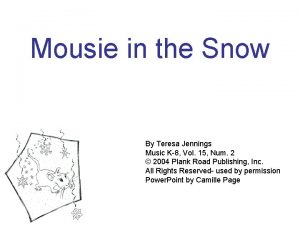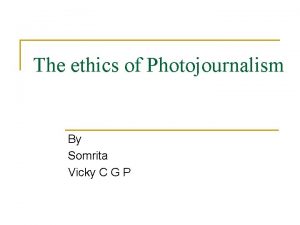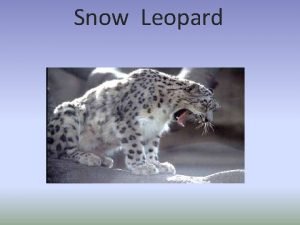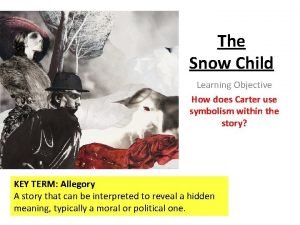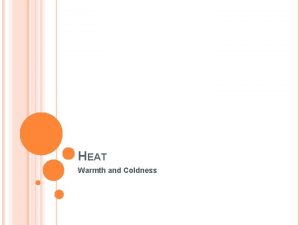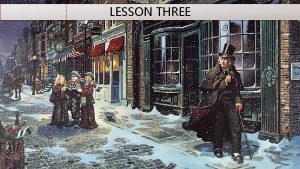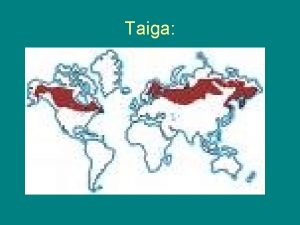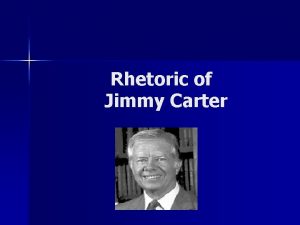The Snow Child Angela Carter Keywordsconcepts Immaculate Coldness













- Slides: 13

The Snow Child Angela Carter

Keywords/concepts Immaculate Coldness Bloodthirstiness Fatality Raven – icon of gothic literature/ mythic/Poe’s The Raven • Patriarchy - shaping women into men’s desires • Symbols – clothing/jewellery, rose • • •

The Snow Child "The Snow Child, as its chilling title suggests, is a stark, uncompromising tale of sexuality as a function of overwhelming male power" Mary Kaiser: Fairy tale as sexual allegory: Intertextuality in Angela Carter's The Bloody Chamber. Review of Contemporary Fiction (1994).

The Countess Black Horse Glittering pelts of black foxes High, black, shining boots with scarlet heels and spurs Gloves Diamond brooch

The Count “I wish I had a girl as white as snow. ” “I wish I had a girl as red as blood. ” “I wish I had a girl as black as that bird’s feather. ” Reversal of traditional fairy tale desire – usually it is the mother figure who wishes for a child. DISCUSS: Sinister undertone – Why does the Count want a child? Compare that desire to a woman’s want for a child. The Fickle Nature of Man: Man is obsessed with only a woman’s appearance and wants variety/multiple partners.

The Rivalry of Women The Countess feels threatened by the Snow Child She seeks to destroy the Snow Child Countess sees the Snow Child as a sexual rival The only way for the Countess to survive is to please her man (reflects societal hierarchy of men over women) Countess wins the rivalry through sympathy but still witnesses infidelity (The Count deflowers the corpse) Restoration of her clothes (her material appearance/status as the Count’s trophy) reassures her of her security

The Count’s Omnipotence The Count has the power to create what he wishes for. (He wishes for a child and the Snow Child appears). He is able to dress/undress women at will. He cannot deny the Countess a rose. WHY? Male Fantasy – The Count’s creation and dressing/undressing of the women reflects man’s sexual fantasy revolving around the appearance/costume of the feminine form. It is only outward beauty that stimulates men. Only when adornments/costumes are removed is a man able to experience empathy. This is shown when the Count reclothes the Countess.

Necrophilia The Count cannot accept the loss of his fantasy without having the opportunity of deflowering her. Therefore, the Count defiles the corpse of the Snow Child to satisfy his dark sexual desires. Once his fantasy is fulfilled, the Snow Child’s corpse disappears. This reflects that man’s desires are changeable and, once fulfilled, will alter. The female is nothing more than something to dominate and exploit. DISCUSS – Why does the Count ‘weep’ at the death of The Snow Child.

The Rose “So the girl picks a rose; pricks her finger on the thorn; bleeds; screams; falls. ” DISCUSS: Why and how does the rose kill the Snow Child? “It bites!” she said. (The Countess) DISCUSS: What does the rose represent? The rose the female genitalia. When the Snow Countrepresents sees the rose as a thing of beauty (it reminds Child it represents her ‘coming-of-age’ or first him ofbleeds the female sexual organ) but the Countess sees the menstruation. notand want the rose vaginal symbol. The as a. Countess reminderdoes of pain danger. Although because serves as the a reminder of sexual painthe inflicted the rose it represents same object to both Count and upon her by Count. stirred by that symbol is utterly Countess, thethe emotion contrasting.

Thursday 10 th March Further exploration of ‘The Snow Child. ’

The Opening Line “MIDWINTER – INVINCIBLE, IMMACULATE. ” DISCUSS: Why has Carter employed capital letters for her three opening words? DISCUSS: What is INVINCIBLE and IMMACULATE? MIDWINTER could be a metaphor of the state of the Count’s desire towards the Countess – their relationship has grown dull to him and he has becoming sexually disinterested. Sexual Fantasies are, however, INVINCIBLE and constant. Fantasies always pan out exactly as the fantasist would desire. Fantasies circumvent reality. Fantasies are perfectly imagined and therefore IMMACULATE.

Essay question “Carter explores base instincts rather than subconscious desires. ” Consider at least two stories from The Bloody Chamber in the light of this comment. (40 marks)

Comparison of responses • Each table has been given a sample response for this essay. Read annotate looking for: A 01, AO 2, AO 3, AO 4 Highlight useful arguments to share with the group.

